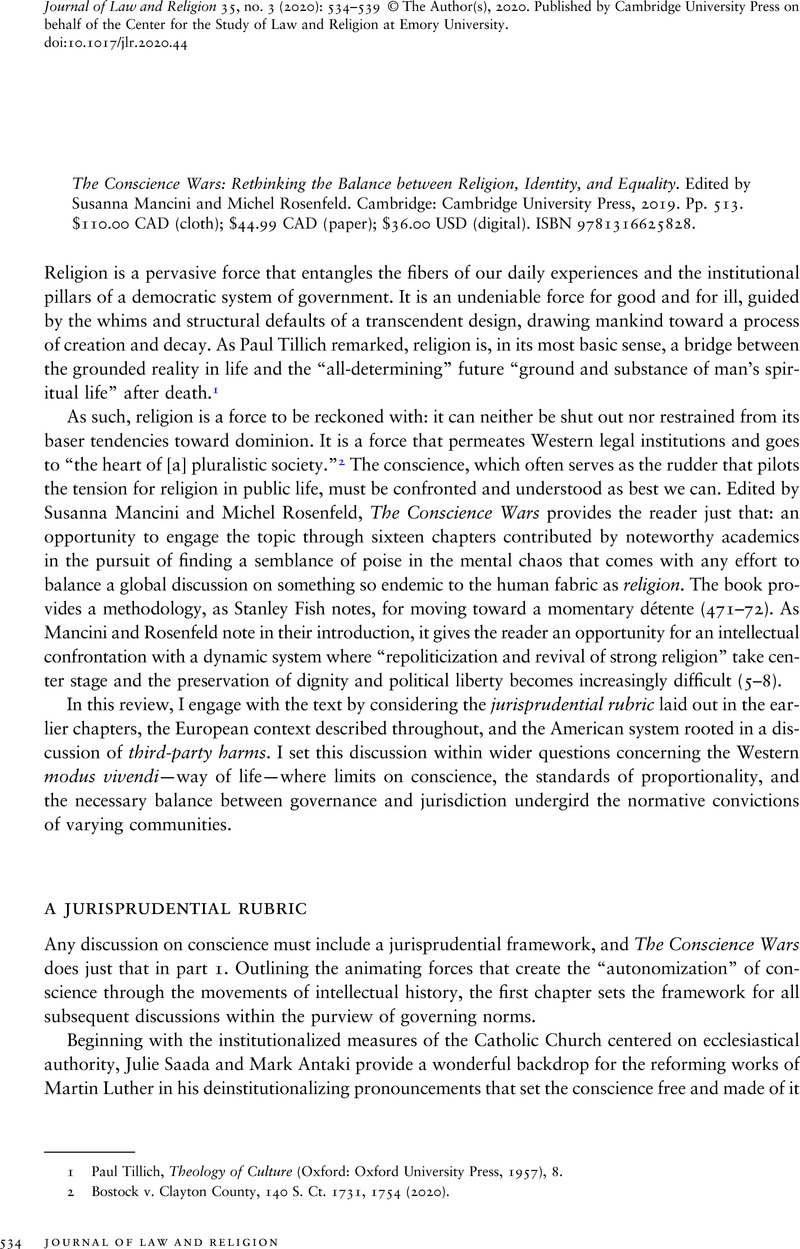No CrossRef data available.
Published online by Cambridge University Press: 09 December 2020

1 Tillich, Paul, Theology of Culture (Oxford: Oxford University Press, 1957), 8Google Scholar.
2 Bostock v. Clayton County, 140 S. Ct. 1731, 1754 (2020).
3 See, for example, Brady, Kathleen A., The Distinctiveness of Religion in American Law (Cambridge: Cambridge University Press, 2015)CrossRefGoogle Scholar; Abner S. Greene, “Liberalism and the Distinctiveness of Religious Belief,” Constitutional Commentary 35 (forthcoming).
4 Elane Photography, LLC v. Willock, 309 P.3d 53, 80 (N.M. 2014) (Bosson, J., concurring).
5 See Koppelman, Andrew, “Gay Rights, Religious Accommodations, and the Purpose of Antidiscrimination Law,” Southern California Law Review 88, no. 3 (2015): 619–59, at 627, 639Google Scholar; Sorkin, Anton, “Make Law, Not War: Solving the Faith/Equality Crisis,” Liberty University Law Review 12, no. 3 (2018): 663–734, at 668–78Google Scholar.
6 Douglas Laycock, “Religious Liberty for Politically Active Minority Groups: A Response to NeJaime and Siegel,” Yale Law Journal Forum, no. 125 (March 16, 2016): 369–86, at 376. Laycock is responding to NeJaime, Douglas and Siegel, Reva B., “Conscience Wars: Complicity-Based Conscience Claims in Religion and Politics,” Yale Law Journal 124, no. 7 (2015): 2516–91Google Scholar.
7 Laycock, Douglas, “The Campaign against Religious Liberty,” in The Rise of Corporate Religious Liberty, ed. Schwartzman, Micah, Flanders, Chad, and Robinson, Zoe (Oxford: Oxford University Press, 2016), 231–55, at 246Google Scholar.
8 See Barclay, Stephanie H., “First Amendment ‘Harms,’” Indiana Law Journal 95, no. 2 (2020): 331–388, at 358–62Google Scholar.
9 Smith, Steven D., “Corporate Religious Liberty and the Culture Wars,” in The First Amendment and Religious Liberty, ed. D., Michael Breidenbach and Owen Anderson (Cambridge: Cambridge University Press, 2020), 334–64, at 353Google Scholar.
10 See, for example, Wilken, Robert Louis, Liberty in the Things of God: The Christian Origins of Religious Freedom (New Haven: Yale University Press, 2019)CrossRefGoogle Scholar; Miller, Nicholas P., The Religious Roots of the First Amendment (Oxford: Oxford University Press, 2012)CrossRefGoogle Scholar; John Witte, Jr., The Reformation of Rights: Law, Religion, and Human Rights in Early Modern Calvinism (Cambridge: Cambridge University Press, 2007).
11 See 1 Corinthians 8–9; Romans 14–15; see also Sorkin, Anton, “‘Them’: Bridging Divides between Distant Neighbors after Masterpiece Cakeshop,” University of San Francisco Law Review 54, no. 1 (2019): 117–88, at 133–42, 156–63Google Scholar (discussing the theological implications of antidiscrimination cases from the stand-point of moral complicity).
12 Also reviewed in this issue.